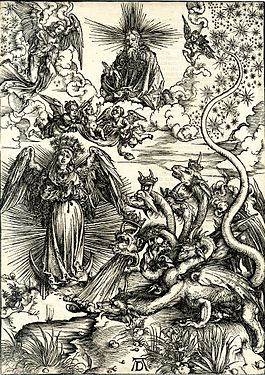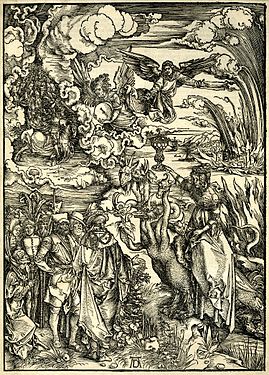User:FawnSpirit/Apocalypse (Dürer)

The Apocalypse, properly Apocalypse with Pictures (Latin: Apocalipsis cum figuris)[1] is a famous series of fifteen woodcuts by Albrecht Dürer of scenes from the Book of Revelation, published in 1498, which rapidly brought him fame across Europe.[2] The series was probably cut on pear wood blocks and drew on theological advice, particularly from Johannes Pirckheimer, the father of Dürer's friend Willibald Pirckheimer. Work on the series started during Dürer's first trip to Italy (1494–95), and the set was published simultaneously in Latin and German at Nuremberg in 1498, at a time when much of Europe anticipated a possible Last Judgment at 1500. The most famous print in the series is The Four Horsemen of the Apocalypse (c. 1497–98),[3] referring to Revelation 6:1–8.[4] The layout of the cycle with the illustrations on the recto and the text on the verso suggests the privileging of the illustrations over the text. The series brought Dürer fame and wealth as well as some freedom from the patronage system, which, in turn, allowed him to choose his own subjects and to devote more time to engraving. In 1511, Dürer published the second edition of Apocalypse in a combined edition with his Life of the Virgin and Large Passion; single impressions were also produced and sold.[5]
Description
[edit]Apocalypse is a cohesive set of woodcuts that depict prominent portions from the final book of the New Testament of the Bible: The Book of Revelations.
Subject Matter
[edit]Significant events within the Book of Revelations
Gallery
[edit]-
1. The martyrdom of St John
-
2. St John's vision of the seven candlesticks
-
3. St John kneeling before Christ and the twenty-four elders
-
4. The four horsemen of the Apocalypse
-
5. The opening of the fifth and sixth seals
-
6. Four angels holding back the winds, and the marking of the elect
-
7. The hymn in adoration of the lamb
-
8. The opening of the seventh seal and the eagle crying 'Woe'
-
9. The four angels of Death
-
10. St John eating the book
-
11. The woman of the Apocalypse and the seven-headed dragon
-
13. The Whore of Babylon
-
14. The beast with the lamb's horns and the beast with seven heads
-
15. The angel with the key of the bottomless pit[a]
The Four Horsemen of the Apocalypse
[edit]Provenance
[edit]Similar cycles
[edit]Jean Duvet's major work was an engraved series from the 1550s, influenced by Dürer but very different in style. Frans Masereel called his World War I series of 25 drawings The Apocalypse of Our Time; in 1943, Benton Spruance made a lithograph titled Riders of the Apocalypse. In 1945 Édouard Goerg published 20 lithographs in a series named The Apocalypse. The Four Horsemen of the Apocalypse and another Dürer engraving called The Sea Beast appeared in the 2007 Russian TV series The Sea Devils 2 (Морские дьяволы-2).
See also
[edit]References
[edit]Footnotes
[edit]- ^ The architectural style of New Jerusalem (background left) was influenced by Dürer's hometown of Nuremberg.[6]
Citations
[edit]- ^ "Apocalypse Then: Dürer to the Twentieth Century". Ackland Art Museum. Archived from the original on 5 September 2008. Retrieved 2008-07-28.
- ^ Giulia Bartrum, Albrecht Dürer and his Legacy, 106, 124-125, British Museum Press, 2002, ISBN 0-7141-2633-0
- ^ "Albrecht Dürer: Four Horsemen of the Apocalypse". Metropolitan Museum of Art. Archived from the original on 5 September 2008. Retrieved 2008-07-28.
- ^ "Albrecht Dürer The Four Horsemen of the Apocalypse, a woodcut". BritishMuseum.org. Archived from the original on 20 August 2008. Retrieved 2008-07-29.
- ^ Bartrum, 124
- ^ Russell, Francis (1967). The World of Dürer: 1471–1528. et al. Time-Life Books. pp. 69, 103.
External links
[edit]- Encyclopædia Britannica entry
- All pieces (Connecticut College Wetmore Print Collection)
- Art-history video commentaries on each plate
















![15. The angel with the key of the bottomless pit[a]](http://upload.wikimedia.org/wikipedia/commons/thumb/b/b3/D%C3%BCrer_Apocalypse_15.jpg/278px-D%C3%BCrer_Apocalypse_15.jpg)